Folk dances from Denmark
Design of music parts
|
| Niels Mejlhede Jensen, Bøgeløvsvej 4, 2830 Virum, Denmark.
e-mail
(web master) |
|
Folk dances from Denmark + a few from Sweden and other countries |
On this page the principles for making the musical arrangement, constructing
the parts, the voices, are shown.
We select the Swedish dance: Snurrebocken
(Whirring Buck) (dance no. 10 on index page),
which is danced much in Denmark.
When making the different parts (the voices) it is important to pay
attention to the dance, the rhythm of the dance, (see the dance
description), so that the music becomes dance orientated. All tones
are selected so that there is no kind of dissonant tension from part to
melody and from part to part, also when played in octave.
Summary of this page:
Chords to be used for this melody
Chord text for the melody is decided
A part, the voice of the next tone in the triad
a third or little more Above the melody (not always the first tone
above)
B part, the voice of the next tone in the triad
a third or little more Below the melody (not always the first tone
below)
C parts, a voice made of tones from A and B
parts
ns part, a simple voice made of tones from A
and B parts and the melody
10 folk dances, a glimpse of the music
of the previous dances.
The parts are written as a score of 12 staves on two pages, each part
as one staff starting on the left page and continuing on the right page
where it ends. (Several 100 melodies are short enough for that, for all
different types of folk dance). The scores are transposed and written to
the different types of instruments, as exact the same for 8 staves, and
with occasionally a very few alterations decided by the range of pitch
for the last staves.
With these scores the musical leader has to plan which instruments
play what and when during the e.g. 6 times a tune is played.
Introduction
We consider the music for C instruments (c1
and c2).
Snurrebocken is in D major (key signature: 2 sharps (kryds)).
The time is 3/4, (but not waltz).
There are 2 different tempos in the music, (besides the pauses (fermat)).
There are 3 beats per bar. Beat 1 is always the strongest, (in all folk
dance music I know of).
See the dance description to get the
right rhymth, which changes during the dance:
For bar 1 - 8 beat 2 is light and beat 3 is marked. So e.g. the accordion
bass plays only beat 1 and 3.
For bar 9 -16 beat 2 and 3 are equal in the dance, so beat 1, 2, and
3 are almost the same. And there is no slur, no tie (ikke binde) from beat
1 to 2 as in waltz. The accordion plays with 3 equal beats. (I accept musicians
that play bar 9 - 16 the same way as bar 1- 8, because the melody is not
so different in structure, and good dancers may even like the little difference
from music to dance).
Chords
First we want to decide the chords to be used by accordion and guitar.
We choose the simple chords: D, A, and G (tonic, dominant,
and subdominant):

Those are the tones that will build the voices, the parts, as shown
on the score.
Chord text
We will now write the chord text (becifring) to the melody, one chord for
each bar. In the same way as you "per intuition" would select the chords
on accordion and guitar:

In bar 1 the melody uses only the 3 notes of the D major triad
(D-dur tre-klang) up and down, so it is a pure D chord.
This is repeated in bar 2.
Bar 3 has the D triad on the first 2 beats, but on the beat
3 with the tone g there is a tension towards the dominant chord
A.
This tension is resolved in bar 4 by selecting the chord A.
But then here the melody on this most important first beat has the tone
f
sharp which is not in the A triad, and this gives a new
tension. The tension is finally relieved on beat 2 and 3 where the melody
has the triad tones of the chosen chord A. (So we do not change
chord in the middle of the bar, on beat 3 in bar 3 to make a pure timbre,
but instead we let the melody develop its little tension, of the sound
of a different chord together with the parts).

Bar 5 is parallel to bar 1 with tones from the dominant chord A,
though not A triad but A7 with the tone g. In bar
7 beat 3 and in bar 8 beat 1 there is tension as discussed for bar 3 and
4.
The chord A triad and not A7 in bar 5- 7 will be used
for making the parts. (Not using the seventh, A7, excludes some nice often
used possibilities, specially in low pitch voices). (For me it is OK if
e.g. accordions play A7 bass here).
In this way we decide the chord text for the whole melody. For the
simple old folk tunes this is usually straight forward with mostly only
one such simple solution, except for a few minor details of discussion.
I have almost everywhere in these folk dance melodies used the chord text
given by Flute Henning in his excellent folk
dance music book.
A part, A voice
Now we construct the A part, the voice nearest above the melody without
dissonance, i.e. a third or little more above. A traditional A voice
could be the one shown here:
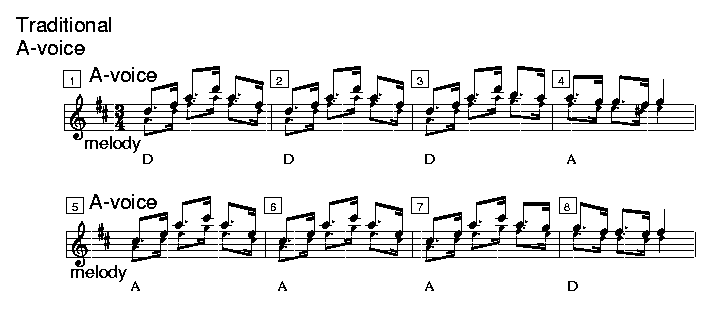
In bar 1 and 2 it is natural to select the tone in the triad a third
or fourth (terst eller kvart) above the melody, giving pure chords as written
in the chord text. In bar 3 beat 3 with g in the melody the tone
a third above is b (= h in German notation), which may be
chosen by a musician wanting to play a two part to the melody. But b
is not part of the chord, so we turn to another proposal:
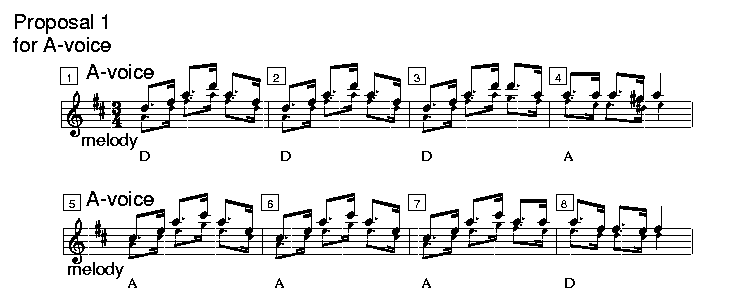
In bar 3 beat 3 with g in the melody the first tone in the D
chord above g is a. But that is too close, giving dissonance,
so the next tone, d is selected. In bar 4 beat 1 a third above the
melody tone f sharp is a, which (happens) to be in A
triad, so a is OK. Bar 5 - 8 are created in the same way, using
only triad tones from A (and not the seventh tone g which
is (can be) in dissonance with the root a).
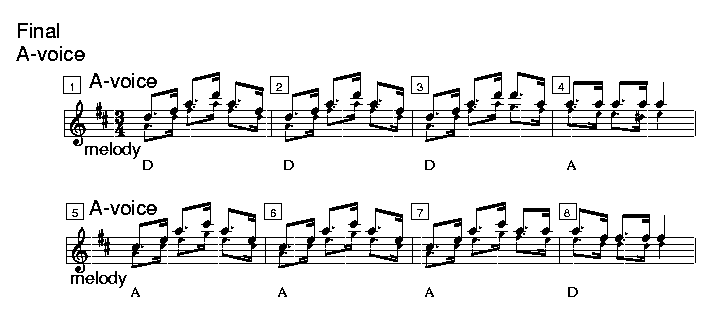
For proposal 1 we considered the tones on the beats. Should then the
tones in between, the unmarked semiquavers (1/16), be chosen more freely
as shown in proposal 1 in bar 4 with g sharp to give a more interesting
melodic form for this voice? In the final selection also these small tones
are chosen from the chord triads, because this makes the many parts of
the whole score more easy to keep out of dissonant conflicts. This gives
for bar 4 only the same tone, a, 5 times, which may seem a tedious
melodic form. But this here is not the melody. Its is a supplement to enhance
the melody. And when you get used to this way of making parts, the sound
of parts should sound that simple to be in the right accordance with the
simplicity of old folk tunes.
I was happy with proposal 1 for a long time. But you have more free
means to make the other parts, the n parts of my score, if you use the
simple principle, the more confined principle, of the final selection.
Intonation is not always easy for folk musician groups, for fiddlers.
In concern of the correct intonation it is better with simple pure harmonies
as proposed here. A few years ago I composed parts for this type of folk
dancing music which even included other tonal systems. I liked the sound.
At rare occasions you may hear such music from a couple of excellent Swedish
groups. But among common folk music groups its is difficult enough to play
even my proposals here with the wanted performance. And the common folk
music groups, the ordinary person, is important for the continuation of
our culture here.
B part, B voice
Now we in the same way construct the B part, the voice nearest below the
melody without dissonance, i.e. a third or little more below. A traditional
B voice could be the one shown here:
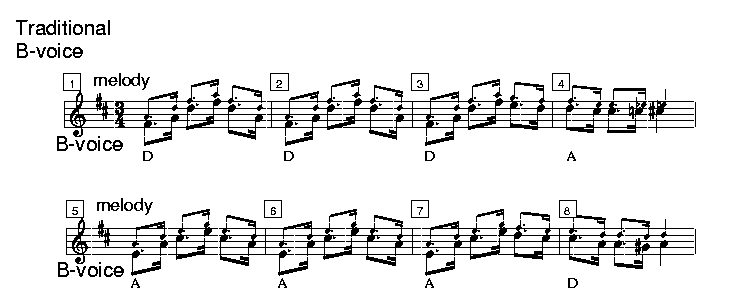
But we want to use the tones of the selected chords on the 3 beats of
all bars, and then we get proposal 1:
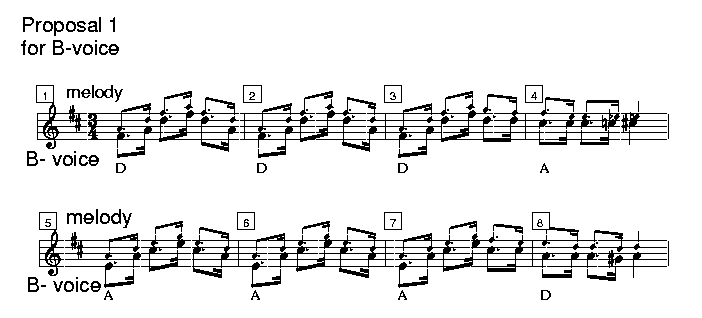
When also the semiquavers off beat are corrected to be part of the chords
we get the final part B:
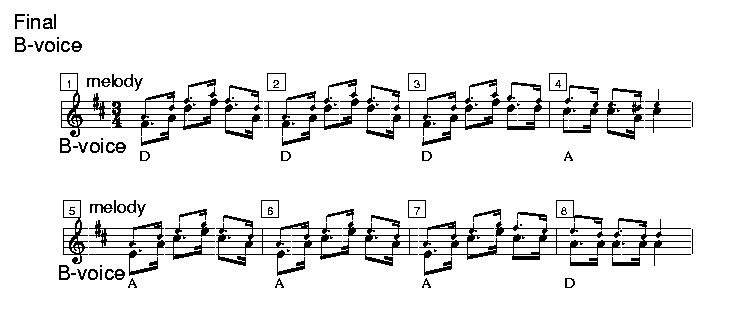
The A and B part are the basic parts, together with the melody. They
could be made by a computer, when the chord text is there, or at least
checked by a computer, like the spelling check. (Is there a program?) This
may sound boring, because this is music alive, where it is the sound, and
not theory that counts.
C parts, C voices
With the tones from A and B parts we make new parts for this dancing music,
C parts or C voices. They can be played together with the melody, or played
as an improvisation to the melody. C parts are then in every tone two parts
to the melody. With tones from the melody included in a more free choice
for improvisations we have the n parts of my score. A more special C part
is the contra part (mod-stemme) which (mostly) moves up when the melody
moves down, etc.
I have wanted to make a simple C1 part and a more lively C2 part. The
C1 part should be more simple to play than the A part and B part, and should
often be simple dance orientated in rhythm. Then the C2 part can be chosen
more freely and maybe used as a so-called solo for a suitable instrument,
with the rest of the band as an underlying "dance motor".
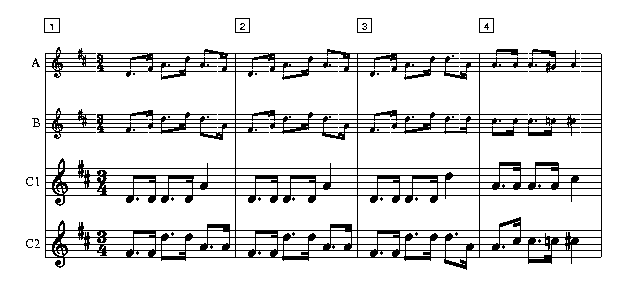
We shall here see how C1 and C2 can be constructed from A and
B of proposal 1 in bar 1 - 4.
For C2 it is possible to use 2 f sharp, 2 d, 2 a,
for (almost) the first 3 bars, and then a different figure in bar 4, all
the way with the exact same rhythm pattern as the melody. (In the final
proposal bar 4 of C2 has to be slightly different from what is shown here).
Constructing C1 we first observe that the dance rhythm is: marked beat
1 and beat 3. To emphasize those beats, the beat 3, I for beat 1
and 2 select 4 alike tones including semiquavers (1/16 note) + then a crotchet
(1/4 note) of higher pitch on beat 3. So that you "kind of run" for the
"pounding" of beat 3. (To make the 4 alike d I have to include d
from the melody on one of the semiquavers).
C1 is easier to play than the melody, and even C2 is not so difficult.
Mostly I want C1 to be easier, to be capable for not so well trained musicians,
or to be used on the "slower" instruments (like bassoon and brass).
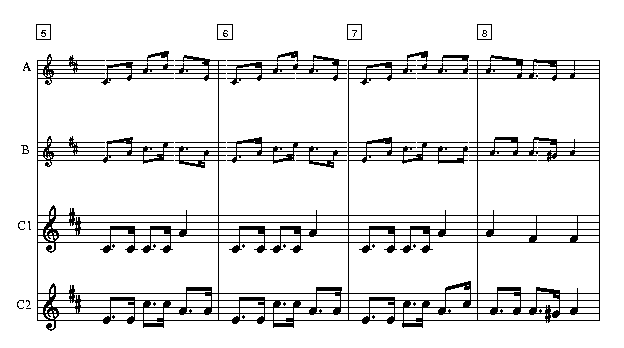
For bar 5 - 8 C1 and C2 are made in the same way. I want C1 to come
to "and end" in bar 8 with 3 crotchets. The beat 2 with f sharp
crotchet here gives a short dissonance with the semiquavers of A and B.
There is no other crotchet solution possible here. With the A and B parts
form the final proposal we do not get this conflict, see the score c1.
More C parts can be made according to these principles, e.g. "altered
A or B parts" all below the melody to be played as two parts to the melody.
The voices made in this way resemble the melody in form, so that it
is felt as a type of imitation. The melody has proved its good dancing
abilities for generations, so this must be the right form.
ns part
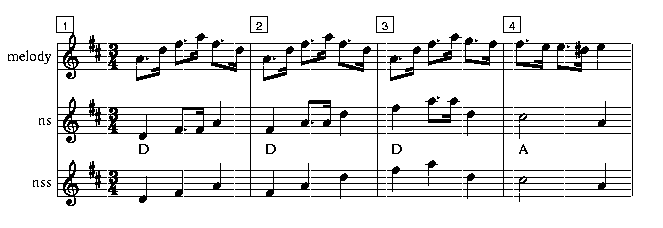
Usually in a musical arrangement you want a simple low voice to give
the tonic feeling and rhythm. To widely use the root note on the first
beat of the bar is not always possible here because of my strict rules
for disharmony. So the melodic form may be more important. In n voices
tones from the melody can be included, giving more freedom. (But still
I prefer that most tones are two part to the melody, because it in bands
of folk musicians like ours usually is more easy to get a lot of musicians
"that happens to drop by" to play the melody than to play by note after
"strange constructed voices").
Usually there are 3 tones to select from in the chord triad, as we
have in bar 1 and 2. But with f sharp in the melody on the important
beat 1 of bar 4 in an A chord, the tone e cannot be selected,
leaving c sharp and a to be used. The note before, g
in the melody with D chord in bar 3 beat 3, leaves only one tone,
the tone
d to be used. (The minim (1/2 note) c sharp in bar
4 is not OK the last 1/16 with the melody semiquaver d sharp, but
the other choice the minim a does not fit in melodically, I feel).
nss is simple and has the right tones. But ns is better in dance rhythm,
which is: marked beat 1 and beat 3 and weak beat 2. To weaken beat 2 and
emphasize beat 3 it is better to use the shown pattern with two notes on
beat 2. The music must not be waltz like, what nss could easily be played.
To avoid the waltz character also in ns the proposal of C1 with the same
note in beat 1 and beat 2 is even better, at least to have in the first
bar with a change of dance style.
So when the dancers shift to running steps in bar 9 I let the ns voice
have 3 alike crotchet tones in each of the first 3 bars.
There is also a shift in style in C1 and C2 in bar 9:

10 folk dances
Before we reached the above analysed dance, Snurrebocken (Whirring Buck),
dance no. 10 on this web site, we had 9 other dances, see
index.
Let us shortly look on some of the music for them:
Dance no. 9, Stødt kanel (Pounded
Cinnamon) is also with the time signature 3/4, but this is all different
3/4. The dance is a waltz all the way through, with 3 beats = 1 pounded
beat 1 + the two lighter beats 2 and 3. So the ns part looks as shown here,
and is played with a slur from beat 1 to beat 2 to give a good "dance motor":

Dance no. 1, Sjijnmyravalsen (Sjijn Bog
Waltz) is a waltz, with some figuring. So the first section, with waltz,
has a C1 part that in the first 3 bars (hopefully) leads the musician to
play waltz:

Dance no. 3, Trommelvalsen (Roller Waltz)
is also a waltz in 3/4, but the dancers are running in the first section
of the dance, so the 3 beats of the bar are more equal, and with no slur
from beat 1 to beat 2 (do not tie beat 1 and 2). This is achieved by making
the 3 tones alike, with the same pitch (tonehøjde):

In dance no. 6, Bitte mand i knibe (Little
man in a fix), we also have running in waltz as a start.
Then we change to the time signature 2/4, to Tater
hopsa (Gipsy Hopsa), dance no. 7. Here we have 2 beats per bar, or
on accordion even 2+2 beats per bar (in a very fast play). But beat 1 is
so much heavier than the rest that you could consider having only one beat
per bar. So to facilitate this one beat per bar, C1 is started with 4 alike
tones per bar:

A polka has also 2 beats per bar (2+2 beats per bar on accordion) (in
a slower tempo). But here beat 2 is more marked (beat 1 is still as always
the most marked). To facilitate a marked beat 2 I let the melodic course
change direction on beat 2, as we see in dance
no. 5, Bedstefars rheinlænderpolka nr ½5 (Grandfather's
Polka no ½5):

We walk a gånglåt in Denmark with 2 slow steps per bar
to adjusted tempo of music. The melody of Gärdeby
gånglåt (Gerdeby Walking Tune), dance no 4, facilitates
this walk with the many groups of semiquavers. And I have made the ns part
with 2 tones per bar = 2 beats per bar. Sometimes you may see a gånglåt
used as a quick march in Scandinavia, played slower and walked with 4 steps
per bar. I have here made a C2 part that is better for 4 steps per bar,
but here to have an interesting solo (e.g. flute, piccolo) as a contrast
to the good underlying motor of the rest of the band playing other parts
in clear 2 beats per bar. (The quaver should be before the two semiquavers
to make it a typical two-beats-per-bar melody). So the musical leader must
think of how the band as a whole sounds in dance rhythm and what the dancers
want (and their skill).

In Fætter Mikkel (Cousin Mikkel), dance
no. 2 you walk in the first section with two steps per bar, as also
given by the contra part here:

I hope that I have made some very easy parts to Fætter Mikkel
because this is a good dance and good music for beginners.
In 2-tur fra Vejle (2-trip from Vejle), dance
no. 8, we also walk in the first section with 2 steps (2 beats) per
bar:

In the second section there is polka.
There are still some types of folk dances and rhythms to come the next
weeks.
FINE:
All the above theory is not more important, than it is how the music
sounds that counts.
Index page.
Bottom of this page




















